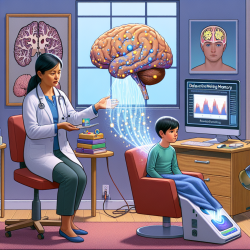Introduction
In the realm of child development, the challenges posed by poverty-related adversity are profound, particularly in low-income, ethnic minority children. A recent study, "Poverty-Related Adversity and Emotion Regulation Predict Internalizing Behavior Problems among Low-Income Children Ages 8–11," sheds light on how emotion regulation (ER) can predict and potentially mitigate internalizing behavior problems in children. This blog post aims to guide practitioners in leveraging these insights to improve outcomes for children facing such adversities.
Understanding the Study
The study examined 338 children from low-income backgrounds, focusing on three key neurocognitive processes of emotion regulation:
- Attention Bias to Threat (ABT): The tendency to focus on threatening stimuli.
- Facial Emotion Appraisal (FEA): The ability to accurately identify and label emotions.
- Negative Affect (NA): The subjective experience of negative emotions.
These processes were analyzed to determine their predictive power on internalizing behavior problems, such as anxiety and depression, in children aged 8 to 11.
Key Findings
The study found that each component of ER independently predicted internalizing symptoms, even when accounting for chronic poverty-related adversity. Specifically:
- Children with a higher attention bias to threat were more likely to exhibit internalizing behavior problems.
- Lower accuracy in facial emotion appraisal was linked to higher internalizing symptoms.
- Higher levels of negative affect correlated with increased symptoms of sadness and anxiety.
Moreover, chronic exposure to poverty-related adversity was a significant predictor of internalizing problems, underscoring the need for targeted interventions.
Implications for Practitioners
For practitioners, these findings highlight the importance of addressing emotion regulation in therapeutic settings. Here are some strategies to consider:
- Incorporate Emotion Regulation Training: Implement programs that focus on improving children's ability to regulate emotions, such as attention bias modification (ABM) techniques.
- Enhance Emotion Recognition Skills: Use tools and exercises to help children accurately identify and label emotions, which can reduce internalizing symptoms.
- Supportive Environments: Create safe and supportive environments that reduce exposure to threatening stimuli and foster positive emotional development.
Encouraging Further Research
While the study provides valuable insights, it also opens avenues for further research. Practitioners are encouraged to explore how these findings can be integrated into broader therapeutic frameworks and to investigate additional factors that may influence emotion regulation and internalizing behavior.
To read the original research paper, please follow this link: Poverty-Related Adversity and Emotion Regulation Predict Internalizing Behavior Problems among Low-Income Children Ages 8–11.










